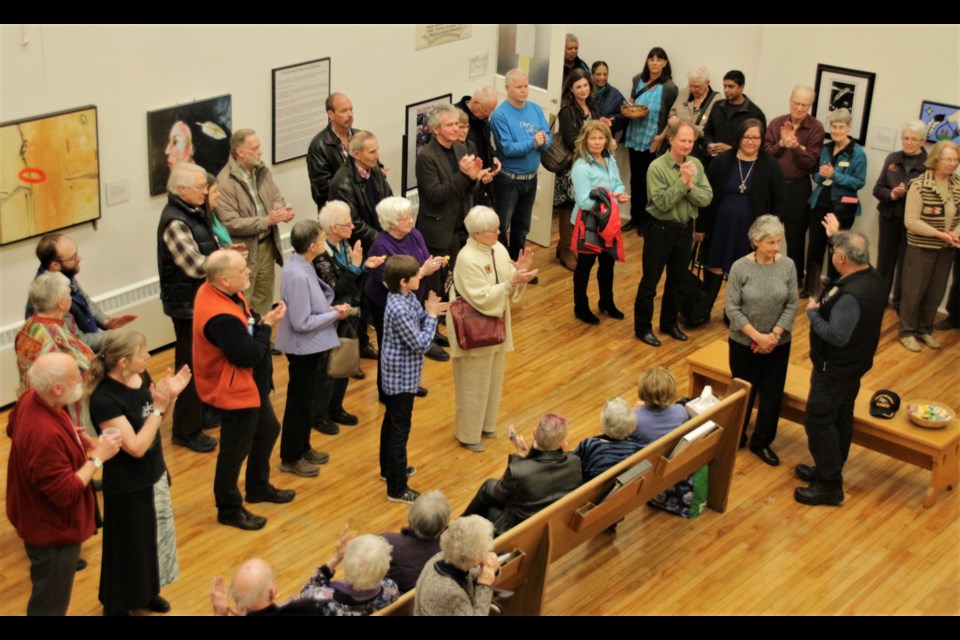The ghosts of lost First Nations generations spoke Sunday through art as a unique exhibition was unveiled at St. Paul’s Centre.
The artwork produced by eight Indigenous and eight non-indigenous artists was a response to one of the calls for action that resulted from the Truth and Reconciliation Commission’s report. It’s why the exhibition has been dubbed Call to Action 83.
On Sunday afternoon, the 16 artists shared the explanations behind their works.
“It was an honour being part of this process,” said Robert Henry of Saugeen First Nation.
“The effects of the residential schools are still here, because I don’t speak my language and am only just learning about my culture,” he told spectators at the event.
Henry’s grandfather was sent to a residential school, where he became friends with a younger boy, who was being abused at the school.
“My grandfather said, ‘If it happens again, I’m taking you home,’” said Henry.
The pair ran away from the school a few nights later.
Surviving in the bush, they were finally able to hitchhike their way to the young boy’s reserve. When Henry’s grandfather returned to Saugeen, he was picked up again and taken to another residential school.
Henry’s own life growing up wasn’t easy.
“I was told growing up that your beliefs are wrong,” he said.
As a young boy, Henry said he was homeless and explained how a priest wouldn’t allow him in the house because Henry refused to say his beliefs were wrong.
“I had a lot of anger growing up,” he said, adding he is glad to see steps being taken to bring Aboriginal cultural education into the school system. His kids can grow up with what he didn’t have: a self-identity.
“We grew up lost in this world,” said Henry.
His painting Sagajiwegiizhik, Coming from the Sun, is a healing painting that is his depiction of his journey on the path to reconciliation.
The 16 artists started working on their pieces a couple years ago following a sweat lodge ceremony and a feast.
Non-Indigenous artist Xavier Fernandes was at the beginning of the line up. His work was passed on to an Indigenous artist, whose production went to a non-Indigenous artist and so on and so forth, until all 16 pieces were completed.
Artist Jeanette Luchese, who is first generation Italian, said she knew about the First Nations history only as it is taught at school.
A little research into the other side of the story opened her eyes.
“I felt very stupid and inadequate because of what I didn’t know,” said Luchese. “It was the Indigenous people’s camaraderie that helped the settlers and how were they repaid?”
Even today, said the Innisfil resident, we read about the suicides among young Indigenous people and the way the missing and murdered Indigenous women cases are being handled.
Her painting, Truth and Nothing but the Truth, was reflective of the new realities she had learned, said Luchese.
On the one end, the painting has vivid colours and ghost-like images of the lost generations of First Nations. On the other end, Luchese said, she used similar bright shades to depict the resilience of the Indigenous peoples.
She hopes this exhibition will open people’s eyes to the true history of the First Nations people.
Reconnecting with the truth was hard for Deanna Peacock.
“The presentations were heartfelt,” said the Orillia resident. “The art is soul searching. I’m so glad I came. The truth is hard.”
Peacock said through experiencing the exhibition she truly felt the loss of the grandmothers and grandfathers of the lost First Nations generations.
For another Orillia resident, it was a humbling experience.
“Acknowledgement is a huge step toward reconciliation,” said Andrew Woodill. “We still have isolated northern reserves and land fractured and poisoned by industrial affluence. This is a drop in the ocean for what has to be a huge step forward.”
It was the appropriate step for the United Church of Canada (UCC) to take, said Ted Reeve, minister at St. Paul’s.
This exhibition is part of a broader effort launched 25 years ago by the UCC, he said, adding the artwork is permanently open for visitors to view.
“The intent is that people and school children will learn about truth and reconciliation with this resource,” Reeve said. “Truly, this is a step toward reconciliation.”
